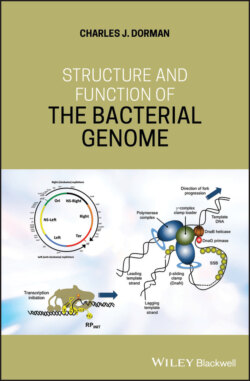Читать книгу Structure and Function of the Bacterial Genome - Charles J. Dorman - Страница 59
1.48 Other H‐NS Homologues: The Ler Protein from EPEC
ОглавлениеLer is a paralogue of H‐NS that controls virulence gene expression in EPEC (Bustamante et al. 2001) and Enterohaemorrhagic E. coli, EHEC (Hansen and Kaper 2009). The principal Ler‐dependent virulence genes are located in the locus of enterocyte effacement, LEE, an A+T‐rich pathogenicity island that has been acquired by HGT (Clarke et al. 2003; Nataro and Kaper 1998) (Figure 1.24). LEE encodes a type 3 secretion apparatus and its effector proteins and consists of five operons: LEE1 to LEE5, with the ler gene being located in LEE1 (Elliott et al. 1998). H‐NS silences transcription throughout LEE (Leh et al. 2017; Shin et al. 2012). Ler, the LEE‐encoded regulator, controls LEE operon expression positively by relieving the transcriptional silencing that is imposed by the H‐NS NAP in LEE (Umanski et al. 2002) and at some other loci (Bingle et al. 2014; Elliott et al. 2000).
Figure 1.24 The genetic switch controlling LEE virulence gene expression in EPEC. The LEE pathogenicity island in the EPEC chromosome encodes a T3SS and its associated effector proteins for mammalian epithelial cell invasion. Transcription of the LEE operons is silenced by the H‐NS protein and this is relieved by the antagonistic action of the Ler DNA‐binding protein, an H‐NS homologue. The ler gene is the first in the LEE1 operon and its transcription is negatively autoregulated by Ler and positively controlled by GrlA (encoded by the LEE island) and the PerC protein that is expressed from the EAF virulence plasmid. Production of PerC depends on the PerA regulatory protein, which also activates the transcription of the bfp operon on the EAF plasmid (this operon expresses the bundle‐forming pilus that attaches EPEC to its target host cells). GrlA is a negative regulator of the flhDC operon, the master switch for bacterial motility: when LEE is activated, the bacteria cease to be motile. GrlA activity is inhibited by the LEE‐encoded GrlR protein. Ler and H‐NS share a common nucleation site and a competition between these proteins determines whether or not LEE genes are expressed. The concentration of the Ler protein reflects the activities of the GrlA, PerC, Ler, and H‐NS proteins at the ler promoter. In enterohaemorrhagic E. coli strains, the Hfq RNA chaperone negatively regulates grlRA post‐transcriptionally and exerts a GrlRA‐independent negative effect on LEE gene expression in stationary phase (Hansen and Kaper 2009). In EPEC, Hfq exerts its effects at grlRA mRNA through the sRNAs MgrR, RyhB, and McaS (see Bhatt et al. 2017).
The LEE system is under complex control that involves plasmid‐encoded regulators in addition to those encoded by genes on the chromosome (Figure 1.24). The EPEC Adherence Factor (EAF) plasmid encodes Bfp type IV (bundle‐forming) pili for adherence to host cells and a perABC operon that is autoregulated through the PerA protein and cross‐regulates the ler gene in LEE1 via the PerC protein. PerC is redundant with the island‐encoded GrlA regulatory protein, another positive regulator of ler transcription. In addition, GrlA represses expression of the flagella master regulator locus, flhDC (Kitagawa et al. 2011; Padavannil et al. 2013). The grlRA operon is the subject of posttranscriptional regulation by the Hfq RNA chaperone (Bhatt et al. 2017; Hansen and Kaper 2009). GrlR is an inhibitor of GrlA activity and it achieves this effect by direct protein–protein interaction at the GrlA HTH motif (Padavannil et al. 2013).
Upregulation of the LEE operons occurs in minimal medium at 37°C and transcription is repressed in EPEC cells growing in LB. Two switches operate in the system to create physiological variety. In one, the PerA protein activates the bfp adherence operon on the EAF plasmid directly and the LEE genes indirectly through PerC (Figure 1.24). Positive auto‐control of perABC transcription by PerA is stochastic, creating sub‐populations of bacteria that maintain a hypervirulent (LEE+) phenotype even if inducing conditions are removed and a second population of non‐virulent (LEE−) cells. Allowing the culture to reach stationary phase resets the system (Ronin et al. 2017).
The second switch involves a competition between Ler and H‐NS for access to a nucleation site upstream of the LEE5 promoter (Leh et al. 2017) (Figure 1.24). Although Ler and H‐NS are paralogues, they create distinct nucleoprotein complexes when they bind to DNA, with the Ler complex favouring transcription and the H‐NS one causing transcriptional silencing (Leh et al. 2017). Stochastic expression of the perABC operon, with downstream effects via PerC on ler transcription, may be expected to tip the balance in the Ler/H‐NS competition back and forth, leading to LEE+ and LEE− phenotypes among members of the EPEC population.
Ler is not a general antagonist of H‐NS because it binds only to a small subset of H‐NS targets in the genome, mostly those associated with the LEE pathogenicity island. The two proteins are dissimilar in amino acid sequence at their N‐termini but share similar C‐terminal domains, including the nucleic acid‐binding domain. However, a key arginine residue, found in Ler but not H‐NS, seems to underlie the more restricted range of Ler binding in DNA. Both proteins rely on an indirect readout mechanism for binding site recognition: in the case of Ler, the introduction of its arginine residue into the minor groove of DNA is permitted at only a subset of H‐NS binding sites (Cordeiro et al. 2011). This represents an interesting example of specialisation within the large family of H‐NS‐like proteins.
